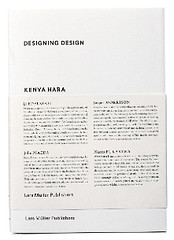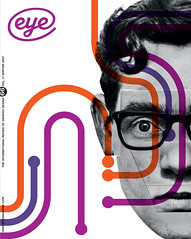Winter 2007
Cool as a Muji candle in the snow
Designing Design
By Kenya Hara<br>Lars Müller Publishers, €39.90, £29.90
 Quiet, patient and smart, Kenya Hara sets his bold ideas in a cool landscape, like candles in snow. Designing Design, at 470 pages, is as white as a prayer book and heavy as a dictionary, and it is a hybrid of monograph and forum for Hara’s essays, which often use his work and the work of others as case studies.
Quiet, patient and smart, Kenya Hara sets his bold ideas in a cool landscape, like candles in snow. Designing Design, at 470 pages, is as white as a prayer book and heavy as a dictionary, and it is a hybrid of monograph and forum for Hara’s essays, which often use his work and the work of others as case studies.
As designer, essayist and exhibit curator, Hara explores a revaluation of values in design, culture and consumerism. The book is a wonder, though less for Hara’s design work than for Hara’s design writing.
Which is to say that his ideas hold far more potential to influence designers than any single creation. To make this point, the book opens with more than 100 pages devoted to the work of other designers (included in Hara’s RE-DESIGN exhibition of redesigned daily objects such as toilet paper rolls, tea bags and matchsticks). The book itself is evidence that Hara’s work cannot be separated from his writing. His designs flow from his imagination and, in turn, feed his imagination. ‘Verbalising design is another act of design,’ he writes on the first page, and in this bold and beautiful book he proves it.
His biography appears on page 467 (award-winning Japanese designer, born 1958; representative, Nippon Design Center; professor, Musashino University), and his own work does not appear until page 122. But do not mistake this for humility. The book recruits four acolytes (Li Edelkoort, John Maeda, Jasper Morrison and Naoto Fukasawa) to praise Hara as philosopher king, design guru and prophet. The publisher must have insisted on these overheated odes. Ignore them, and remove the awkward half-wrapper and sticky dust jacket.
The fabric of the hardcover, in contrast, feels intimate, smudging during reading. Tactility turns out to be one of Hara’s design concepts. In the chapter ‘Haptic’, which relates to touch, he presents, from another exhibit, redesigned objects: tadpole coasters, gel doorknobs and juice boxes covered with simulated fruit skins, soft and seedy. The ‘Senseware’ chapter invites designers to consider touch, sound and even memory as they search for new dimensions in their work. He presents his own designs (signage for hospitals and galleries, books for corporate clients and the Nagano Winter Olympics) not as models but as attempts in this direction.
Hara moves from the small world of daily objects, the miracle of paper and the meaning of white, to breathtaking panoramas of broad horizons (the Muji advertising campaign), Japan’s unique perspective on Western culture and commerce, and his intellectually rigorous proposal (rejected) for the World Exposition 2005, held in Japan. For Muji, Hara counters the reckless exuberance of Western consumerism with the restraint of a mature economy, prompting people to say not ‘I want this’ but rather ‘This will do’. Simplicity, sincerity and respect for the complexity of humanity’s relationship to the natural world are his alternatives to the youth-obsessed and sex-crazy values of Western capitalism. Where does design go from here? Hara offers a view. Don’t miss it.
Top: spread shows posters for Matsuya Ginza Renewal Project, 2001, using embroidered illustration.
First published in Eye no. 66 vol. 17 2007
Eye is the world’s most beautiful and collectable graphic design journal, published quarterly for professional designers, students and anyone interested in critical, informed writing about graphic design and visual culture. It is available from all good design bookshops and online at the Eye shop, where you can buy subscriptions, back issues and single copies of the latest issue. You can also browse visual samples of recent issues at Eye before You Buy.


